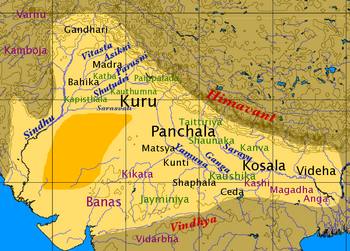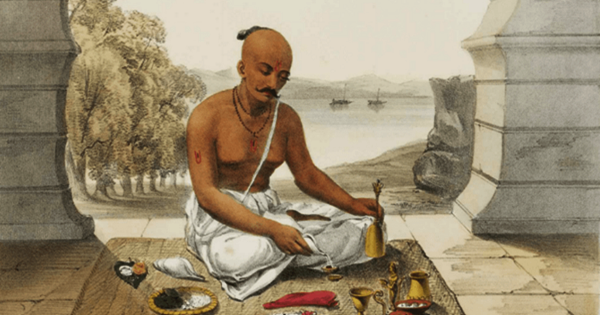While doing a mental worship of Shiva, a devotee should worship lord Ganesha by following the 'Nyas' mode of worship. After that he should worship various deities related with lord Shiva like Nandi etc. Then he should bring the form of lord Shiva into his imagination and worship him mentally by making mental offerings.
The devotee should then perform Havana in the navel of lord Shiva by offering ghee. The worship should be accomplished by meditating on the form of Shiva.
The devotee should take his seat only after purifying it. He should take a vow after completing all the necessary rituals like 'Achaman'. Pranayama, tying a knot in his Shikha.
After doing the 'Deepa Pujan' he should worship various deities like Sun god, Moon god, Varuna, Ganesha and Kartikeya etc. He should then worship both Shiva and Shakti by employing all the sixteen modes of worship (Shodasopachar). The devotee should perform 'arti' in the end.
In the specialized form of Shiva's worship 'Awaran Pujan' of Shiva is done along with the normal pujan. Awaran Pujan means worship of all the articles connected with lord Shiva like his trident his drum etc. In this specialized worship the Shiva's idol should be bathed first of all. Then the idol should be clothed. A sacred thread should be offered to the Shiva's idol along with the other offerings like 'tilak', Akshat etc. After this the 'awaran pujan of Shiva should be done along with the worship of Shiva's family.
If the devotee feels that something was lacking in the worship, he should atone for that mistake by chanting the Panchakshar mantra Om Namah Shivay.
METHOD OF PERFORMING 'HAVANA'
While performing a Shiva Yagya a devotee should make offerings to the 'havanakunda' made of iron or mud. Fire should be ignited in the havankunda following the methods as prescribed in the scriptures. He can then commence the actual worship.
The devotee should make of offerings of ghee with Sruva (a wooden spoon) and other articles with his hands. The offerings should be first made in the names of lord Brahma (Prajapati) then to the nine planets and other deities. After that offerings should be made in the name of the chief deity.
The devotee should then make nine offerings to each of the deities like Agni, Vayu and Surya etc. At last he should perform the arti and atone for those mistakes, which he might have committed during the whole process of worship. He should also give donations to the brahmins and feed them.
AUSPICIOUS DAYS FOR DOING SHIVA WORSHIP
The eighth day and the fourteenth day of both the fortnights of each Hindu month are considered to be the most auspicious for the worship of lord Shiva.
Similarly the solstice day (Sankranti), when the sun is positioned north of equator and eclipse day are considered to be very auspicious. On these days a special worship of lord Shiva should be done by bathing the Shiva idol with Panchagavya and having it is prasadam. It frees a man from the gravest of sins. Similarly the day of 'Pushya' Nakshatra falling in the month of 'Pausha' is considered as very auspicious and performing arti of Shiva on this day gives immense virtues.
Making donations of Ghee and blankets on 'Magha Nakshatra' falling in the month of Magh gives immense virtues.
The following days are considered to be the most auspicious for the worship of lord Shiva.
Uttara Falguni Nakshatra on the same day as Purnima, in the month of Falgun.
Chitra Nakshatra falling on the same day as Purnima in the month of Chaitra.
Vishakha Nakshatra falling on the same day as Purnima, in the month of Vaishakh.
Moola Nakshatra falling in the month of Jyeshtha.
Uttarashadha Nakshatra falling in the month of 'Ashadha'.
Shravana Nakshatra falling in the month of Shravana.
Uttara bhadra Nakshatra falling in the month of 'Bhadra'.
Purnima in the month of Ashwin.
Kartika Nakshatra falling on the same day as Purnima in the month of Kartik.
Ardra Nakshatra falling in the month of Margasheersha.
DESIRABLE RITUALS (KAMYA KARMA)
Rituals can be categorized in to two types-
1) Rituals performed with the objective of fulfilling worldly desires. 2) Rituals pertaining to Ultra mundan desires.
In general, rituals can be classified into five categories - rituals, penance, chanting of mantras, meditation, and all the four collectively.
For performance of rituals a man needs power and strength and one can not achieve power unless and until Shiva wishes it. It is only with the blessings of Shiva that a man can attain both worldly pleasures as well as liberation.
These rituals (Kamya Karma) are performed by making a mandal facing towards east and doing 'awaran pujan' as well as worship of lord Shiva. Worship of lord Shiva done in this way fulfills all the desires of a man.
The methods for the worship of five 'awarans' of Shiva have been mentioned in Shivamahastotra. Each of the 'awarans' have separate presiding deities, the worship of which should be done according to the methods as described in the Shiva Purana or as per the instruction of Guru.
INSTALLATION OF SHIVALINGA
According to the scriptures, a Shivalinga should be made in an auspicious moment. The land, where the Shivalinga is supposed to be installed should be purified by performing 'Bhoomi-Pujan'.
After bhoomi-Pujan, worshipping lord Ganesha should be done. After that, the Shivalinga should be purified by washing it with panchgavya and after worshipping it, it should be immersed in the water.
The Shivalinga should be then taken out from the water and after worshipping it, it should be laid down on the bed meant for him. It should be then installed at the desired place and should be consecrated by chanting the mantras. All the rituals should be performed as per the instructions of Guru.
CLASSIFICATION OF YOGA
Yoga means such actions, which after pacifying all the human tendencies helps a man to unite with Shiva. Following are the five divisions of yoga- 1) Mantra Yoga, 2) Sparsh Yoga (union of touch), 3) Bhava Yoga (union by devotion), 4) Abhava yoga (Union without being emotionally attached), 5) Mahayoga (The great union).
Mantra yoga helps a man to understand the meaning of mantras and uniting with Shiva by the concentration of mind. When Mantra yoga is perfected by the practice of Pranayama it is called 'Sparshyoga'. Bhavayoga means meditating and chanting without uttering a word. Abhava yoga means such a union when the devotee contemplates on the final annihilation, without being emotionally attached with the world.
A man whose mind is preoccupied with the thoughts of Shiva is supposed to have attained the state of Mahayoga. A yogi can unite with Shiva after purifying his body with the help of Pranayama etc.
OBSTACLES AND DIVINE POWERS IN THE PATH OF YOGA
There are possibilities of numerous obstacles being faced by a man who practices yoga like laziness, disease, carelessness, lack of concentration, confusion and sorrow etc. While practicing yoga, one must try to keep himself free from such demerits.
After becoming liberated from these flaws a man can easily attain six types of accomplishment - talent (Pratibha), super power of hearing (Shravana), excellent conversational power and power of speech (Vrata), Divine sight (Darshan), Divine power of taste (Aswad), Divine power of touch (Vedana). The capability of seeing things situated at distant places is called 'Pratibha'. The ability to listen without making any effort is called 'Shravana'. The ability to decipher the meaning of animal's language is called 'Vrata'. Being able to see divine things without making any effort is called 'Darshan'. The power, which enables a man to know about the taste of a thing without actually tasting it, is called 'Aswad'. 'Vedana' means the knowledge of all types of touch.
A devotee can attain all types of accomplishment merely by having devotion towards lord Shiva and by meditating on him. In the beginning, a yogi should try to meditate on the form of Shiva (Saguna), but later on the switch over to Shiva's formless (nirguna) quality. Meditating on nirguna form of Shiva is not easy. It can be mastered only by constant and steady practice. When mastered it bestows all kinds of accomplishment.
Meditation combined with Pranayama gives four types of accomplishments peace (Shanti), tranquility (Prashanti), luster (Dipti) and boon (Prasad). A devotee can have a darshan of lord Shiva if he does meditation with non attachment.








 Describing about the various types of Yoga, Suta told the sages that there were three types of Yoga - Gyan Yoga, Kriya Yoga and Bhakti Yoga. "Each of them is capable of giving salvation to a man. When the mind or intellect unites with the soul it is called Gyan Yoga. When the soul gets attached with external objects, it is called Kriya yoga.
Describing about the various types of Yoga, Suta told the sages that there were three types of Yoga - Gyan Yoga, Kriya Yoga and Bhakti Yoga. "Each of them is capable of giving salvation to a man. When the mind or intellect unites with the soul it is called Gyan Yoga. When the soul gets attached with external objects, it is called Kriya yoga. 
